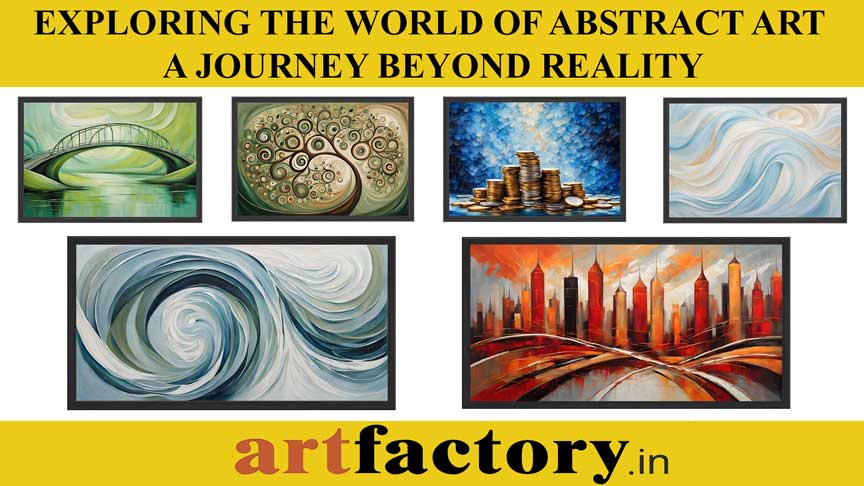
Exploring the World of Abstract Art: A Journey Beyond Reality
Abstract art is a fascinating and liberating form of artistic expression that transcends the boundaries of traditional visual references. It invites viewers to embark on a journey of imagination and emotion, where the beauty lies in the interpretation. Whether you are an art enthusiast or someone looking to add a touch of sophistication to your home, abstract art offers endless possibilities. In this blog post, we will delve into the world of abstract art, its origins, famous artists, and why it has become a popular choice for modern interiors.
The Origins of Abstract Art
Abstract art emerged in the late 19th and early 20th centuries as a reaction to the decline in popularity of realism in artistic impressions. Pioneers like Wassily Kandinsky and Kazimir Malevich sought to break away from conventional representational painting and explore the expressive potential of art. Their works aimed to convey emotions and ideas through the use of color, shape, and form, rather than depicting recognizable objects or scenes. This revolutionary approach opened up new avenues for artistic expression and laid the foundation for modern art as we know it today.
Famous Abstract Artists
The world of abstract art is rich with influential artists who have left an indelible mark on the art scene. Here are a few notable names:
Wassily Kandinsky: Often considered the father of abstract art, Kandinsky's works are characterized by their vibrant colors and geometric shapes. His paintings evoke a sense of spirituality and emotional depth.
Kazimir Malevich: Known for his Suprematist compositions, Malevich explored the relationship between geometric forms and the surrounding space. His iconic "Black Square" is a testament to the power of simplicity in abstract art.
Mark Rothko: Rothko's large-scale color field paintings are designed to evoke profound emotional responses. His works often feature soft, rectangular forms in rich, muted colors that seem to glow from within.
Ernst Ludwig Kirchner: A key figure in the German Expressionist movement, Kirchner's works are characterized by bold, vivid colors and dynamic brushstrokes that capture the essence of modern life.
Marcel Duchamp: Duchamp's innovative approach to art challenged traditional notions of what art could be. His "readymades" – ordinary objects transformed into art – questioned the very definition of art.
Arshile Gorky: Gorky's abstract paintings blend elements of Surrealism and Abstract Expressionism. His works are known for their organic forms and rich, layered textures.
The Beauty of Abstract Art
Understanding abstract art can be a deeply personal experience. Unlike representational art, abstract art does not rely on visual references to the real world. Instead, it invites viewers to engage with the work on an individual level, allowing for a wide range of interpretations. This freedom of interpretation is one of the main characteristics of abstract art, making it a unique and powerful form of expression.
Why Choose Abstract Art for Your Home?
Abstract art has become increasingly popular for home decoration due to its versatility and ability to add a touch of sophistication to any space. Here are a few reasons why you should consider incorporating abstract art into your home:
Personal Expression: Abstract art allows you to express your unique taste and personality. Choose a piece that resonates with you and reflects your individual style.
Versatility: Abstract art comes in a wide variety of styles, colors, and sizes, making it easy to find a piece that complements your existing decor. Whether you prefer bold, vibrant colors or soft, muted tones, there is an abstract painting that will fit your aesthetic.
Sophisticated Look: Adding an abstract painting to your living room, bedroom, or office can instantly elevate the space, giving it a chic and sophisticated appearance.
Long-Lasting Quality: Many abstract paintings are reproduced on museum-quality canvas and paper, ensuring that they will last for years to come. These high-quality reproductions are often indistinguishable from hand-painted originals.
How to Buy Abstract Art
When purchasing abstract art, it's important to consider a few key factors:
Quality: Look for high-quality reproductions on museum-grade canvas or paper. These materials ensure that the colors will remain vibrant and the artwork will last for many years.
Artist Reputation: Choose works by renowned artists or emerging talents whose style you admire. This not only ensures the authenticity of the piece but also adds value to your collection.
Personal Connection: Ultimately, the most important factor is your personal connection to the artwork. Choose a piece that speaks to you and brings you joy every time you look at it.
Conclusion
Abstract art is a captivating and versatile form of artistic expression that offers endless opportunities for personal interpretation and enjoyment. Whether you are a seasoned art collector or a first-time buyer, there is an abstract painting out there that will resonate with you. By understanding the origins, famous artists, and benefits of abstract art, you can make an informed decision and add a touch of sophistication to your home. Explore the world of abstract art today and discover the beauty that lies beyond reality.

Comments : (0)